What is Chambray and is it the Best Casual Shirt Fabric?
Many guys might not even know what chambray is; because it usually alternates blue and white threads, the untrained eye will mistake it for denim.
But chambray is a completely different beast — it’s softer, lighter, more versatile, and more textured, all while remaining very strong for its weight.
It was originally workwear, but because this less ubiquitous fabric doesn’t have the cultural baggage of denim, I’m just going to say it: chambray makes the best casual shirts.
To explore this topic I spoke to two icons of menswear YouTube: the vintage-focused Jake at Almost Vintage Style and the slightly more timeless Peter from Peter’s Prism.
Below I’ll explain what chambray is, why it’s criminally underrated, and show some examples of how to wear it.
What is Chambray?
- Originally a linen fabric, it gained popularity as a lightweight cotton weave used as workwear
- It’s tough, breathable, and doesn’t really need ironing
- It’s a plain weave, so it has a more “cross hatched” look (like canvas)
- Usually made from alternating blue and white yarns
Chambray’s origins seem to lie in 1500s France where it was named after Cambrai, the town where it was first produced.
A lightweight, plain-weave fabric, it was originally made of linen, but became widespread by the early 1900s as a cotton weave for workwear shirts. These shirts became iconic for workers for their balance of breathability, durability, and affordability.
“I genuinely think chambray shirts are the best casual shirts that guys can buy,” says Jake. “They’re even more versatile than white t-shirts in terms of levels of formality or situations you can wear them in. Also, not everybody looks amazing in a white t-shirt, but chambray shirts can flatter almost anybody.”
A classic chambray work shirt featuring soft, breathable, but durable cotton fabric.

Texture
Like denim, you’ll sometimes find chambray in different colors (probably red/white) but blue/white is by far the most common.
Because of those alternating colors and the tough plain weave, chambray is a bit mottled in appearance, it doesn’t wrinkle much, and the color does a good job of hiding any wrinkliness.
That’s in stark contrast to linen, of course — which is why a lot of dudes prefer chambray for a summer shirt.
That texture combined with chambray’s association with workwear lends it a rugged aesthetic that remains stylish today — again, like denim. Speaking of which…
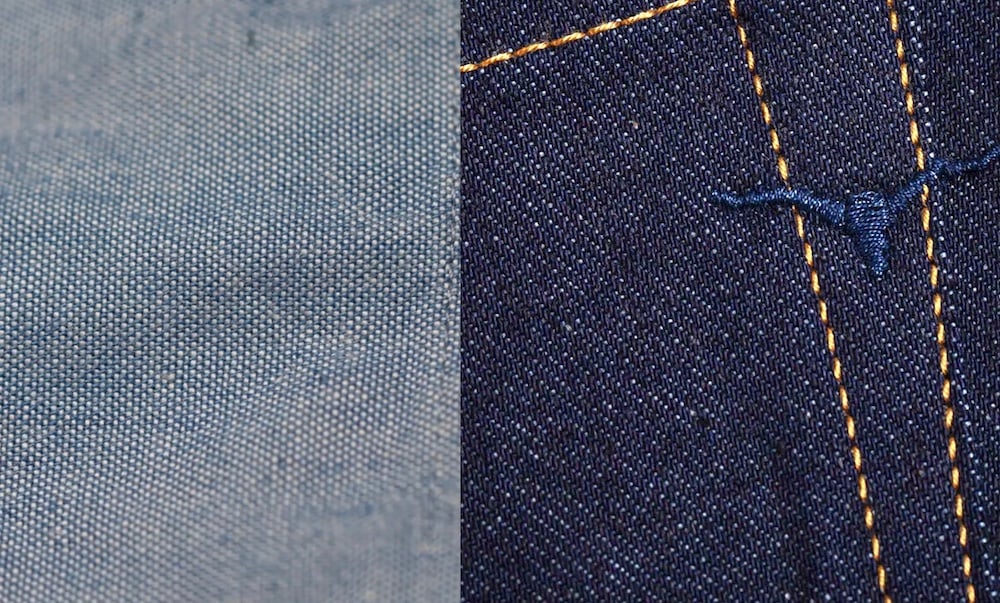
Chambray vs Denim
- Both chambray and denim are durable cotton fabrics with origins in workwear.
- Chambray is a plain weave, so it has a cross-hatched look
- Denim is a twill weave, so the surface looks more like diagonal lines
- Chambray is usually lighter weight and used for shirts
- Denim is usually heavier and used for pants
Chambray resembles denim because it’s a casual workwear fabric that’s usually comprised of alternating blue and white yarns.
“But if you have a denim shirt, it’s very different from a chambray shirt,” says Peter. “Chambray as a fabric has a certain quality that is a little softer, it has a neppier texture. And chambray is a plain weave as opposed to denim, which is a twill weave.”

Your typical chambray is lighter in weight than denim and is much more likely to be used for shirts than pants. But because it’s a plain weave fabric, chambray is comparable in strength to a (slightly) thicker denim, making it a great lighter weight option for a shirt. It’s not uncommon to find 6-ounce chambray, like the Dean from Grown and Sewn, which is about half the weight of your average jean.
“Chambray just feels easy against the skin,” explains Peter. “It’s never stiff or suffocating, even when you’re layering it.”
(Denim has heaps of its own benefits: it has more give and conforms better to your body’s shape with wear, but this isn’t an article about denim. Learn more in our guide to denim vs canvas, another plain weave fabric that’s more often used for pants.)
Further Reading
8 Ways to Wear a Denim Shirt (Any Time of Year)
For something a little heftier and plenty of its own character, check out our guide to denim shirts. Learn more →

Choosing the Right Weight
Lightweight chambrays (around 6 oz per square yard) are perfect for summer shirts. Medium weights (7-8 oz) work well for year-round layering. Heavier chambrays can be used for outerwear and tough work shirts, though they’re pretty uncommon.
If you’re not purposely looking for something for summer, don’t worry too much about the weight — you can always layer over chambray in cooler weather.
Note that this fabric is practically always made of cotton, but the first chambray was linen, and some brands (like Proper Cloth) sell linen or linen-blend versions. Because of the mottled texture, linen chambray conceals wrinkliness better than other linen shirts.

How to Wear Chambray
- The texture pairs well with linen; try with linen pants and suede loafers
- Pair a plain shirt with chinos and derbies or loafers for business casual
- Wear fatigues with boots for a more rugged look
- Chambray and jeans pair well without giving a “denim tuxedo” vibe
- Avoid chambray for situations that need a tie
Every now and then, a brand will find a thick chambray and make some pants out of it, but it’s never a staple product — chambray is practically always used for shirts.
“I think chambray, at least among most men I know, is universally considered one of the most versatile shirt options in their closets,” says Peter. “It’s great with jeans, great with chinos, great with white, great with fatigues.”
A classic chambray work shirt featuring soft, breathable, but durable cotton fabric.

Can Chambray Be Formal?
But it’s typically considered a casual fabric — a little more versatile than denim, but not by a lot. Peter has some rules for gauging the dressiness:
“I think the more details that you have in your chambray shirt, the more casual you want to be with it,” he says. “The more contrast stitching, the more pockets, the more conspicuous the pockets — these are all details that are rooted in workwear and dress down a chambray shirt. But I have a J. Crew one that’s almost completely plain, and I’m comfortable dressing that up a little with wool trousers.”

Chambray and Jeans
Your jeans are probably your default pants, we’re arguing for chambray as your default button-up, but can you wear them both at once?
“I think chambray against a twill fabric presents a great contrast,” says Jake. “Chambray works with denim too, because denim is a twill and has a different weight, so you get a good amount of contrast. They both have texture, but the texture is not the same. They work amazingly well together because they are both casual fabrics, but not the same kind of casual fabric.”

Chambray and Fatigues
Sateen, often used for military fatigues, has a subtle horizontal weave pattern and was popular for jungle warfare: it’s tough, breathes well, and dries quickly. This all makes it great for summer trousers.
Sateen is mostly associated with fatigues, which are very casual. But some brands (like Benzak Denim Developers) make chinos from sateen, which are great for taking chambray to a slightly smarter place than fatigues can.

Chambray and Chinos
“If you wear a chambray shirt with chinos, you’re more casual, but it’s also a sign that you know how to dress,” says Jake. “Honestly, to me, when I see somebody wearing a chambray shirt with chinos, it’s a sign that someone actually thought about what to wear.”
Just note that chinos actually originated as workwear too, and a lot of menswear enthusiasts will insist they can’t be dressed up.
But that debate is immaterial here, because the one thing most guys should avoid with chambray is a tie! It can be done, but it has to be done very thoughtfully — and we’re trying to make guidelines that are easy to remember.
Further Reading
Jeans vs Chinos: Key Differences and When to Wear Each
We visit Amsterdam and visit a brand that makes both to learn all the details that laymen miss. Learn more →
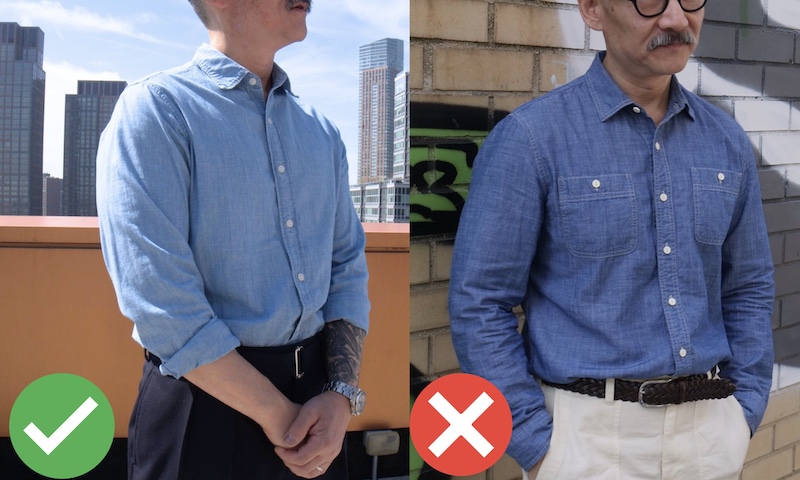
Business Casual Chambray Shirts
Chambray shirts can work for business casual, but make sure you pick one that’s low on details. We contrasted the right and wrong kind of shirt above — Peter’s J. Crew shirt on the left could probably work with a knit tie.
“You can absolutely wear chambray in business casual environments,” explains Peter. “Especially if it’s tucked into nice chinos or even a lightweight summer suit.”

If “business casual” doesn’t require a tie, then you’ve got more freedom. Strictly speaking, the Proper Cloth shirt I’m wearing with chinos above isn’t ideal for dressing up, it can work if it’s tucked in with chinos and loafers or derbies — the more “casual” side of “business casual.”
Further Reading

Best Selvedge Denim: 9 Solid Brands Expert Tested for Quality, Value, & Weirdness
We’ve spent years finding the best selvedge denim market for guys who want durable casual jeans. Learn more →

Tucked or Untucked
It’s usually best to tuck in a button up shirt, especially if you’re not wearing jeans with it. But as a shirt with more casual roots, it’s easier to leave chambray untucked if you want to.
“Chambray shirts usually have that casual vibe, so untucking them often feels more natural,” says Peter. “But if you need to polish it up a bit, tucking them in works great.”
“I love tucking my shirts in,” says Jake. “But I do think a chambray is easier to wear untucked. Especially compared to an Oxford cloth button down.”

Chambray Shirts Vs. Oxford Cloth Button Down (OCBD)
- Oxford cloth is thicker and more rigid than chambray
- OCBDs are best suited for business casual or smart casual; chambray is best suited for casual
Fabric-wise, chambray breathes better than the burly Oxford cloth. Style-wise? While Oxford cloth button-downs are a staple for many guys, people are more likely to think of an untucked OCBD as looking a little sloppy, especially if done so with jeans. I’m not saying that’s definitively the case, I’m just trying to tell you what kind of spectrum they occupy on the dressy-to-casual meter: it’s more likely that someone will think you should tuck in an OCBD than a chambray.
A classic Oxford cloth button-down that's perfect for business and smart casual occasions.
“They both can be worn casually,” explains Peter. “But I feel like the Oxford cloth button down for me has a connotation that’s a little bit more prep.”
You can wear Oxford cloth casually, but it is usually thicker and better suited for cooler temperatures.
“Good oxford cloth button downs have a nice fabric, but they can feel stuffy when worn with jeans and chinos,” says Jake. “Chambray has texture, maintaining a casual and relaxed feel without the stiffness of dressier button-up shirts, plus it’s more versatile in terms of weather.”
Final Thoughts
Chambray is a timeless, versatile fabric perfect for building a stylish, breathable summer wardrobe. Whether you’re layering it with denim, linen, or wearing it as a relaxed denim alternative, chambray offers durability, softness, and casual refinement.


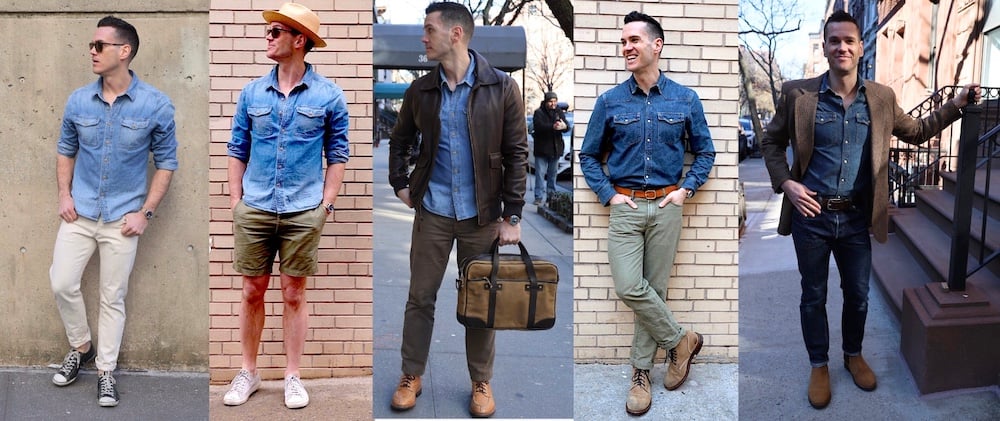
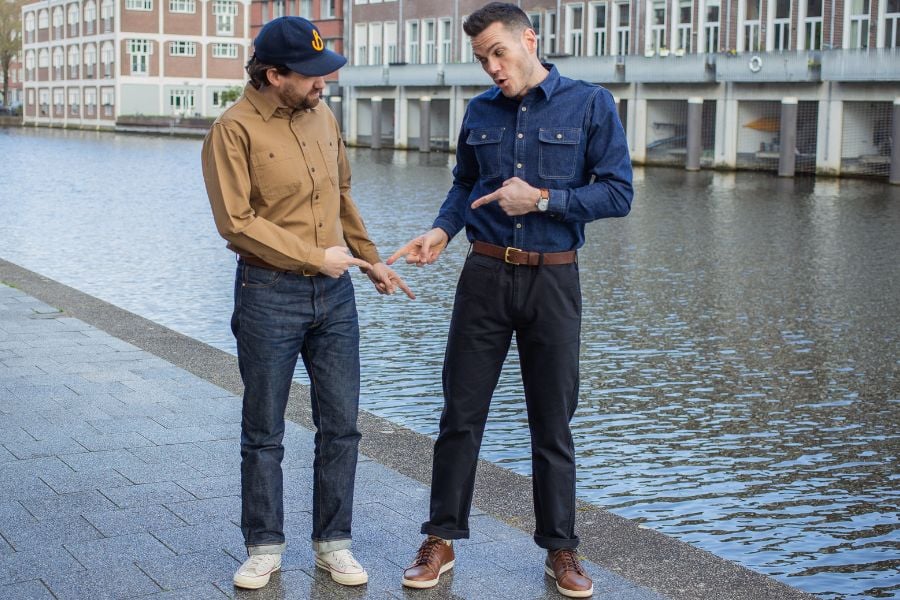



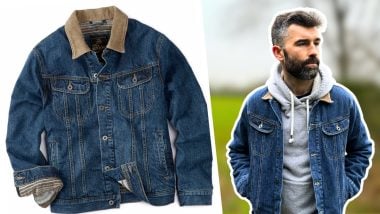
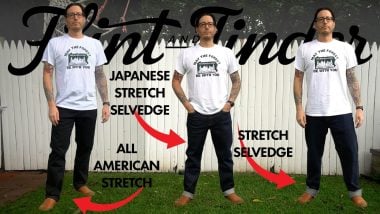



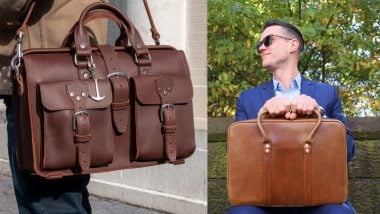

Join the Discussion